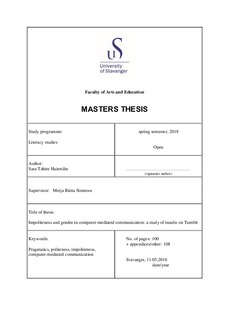Impoliteness and gender in computer-mediated communication: a study of insults on Tumblr
Master thesis
Permanent lenke
http://hdl.handle.net/11250/2504270Utgivelsesdato
2018-05Metadata
Vis full innførselSamlinger
- Student papers (HF-IKS) [905]
Sammendrag
This thesis is a comparative study of impoliteness techniques employed by different genders in computer-mediated communication (CMC) in the context of the microblogging website Tumblr. It uses a modified version of Culpeper’s (1996) impoliteness framework to categorize and analyze the data collected on Tumblr. Culpeper’s (1996) framework is based on Brown and Levinson’s (1987) politeness theory, which is one of the most influential work in the field of linguistic politeness. According to Brown and Levinson (1987: 61) everyone has a “face”, a public self-image that they wish to maintain and protect. A person’s face consists of two separate aspects, negative face and positive face. Negative face refers to one’s wish to be free from imposition whereas positive face is concerned with being accepted and belonging to a group (Brown and Levinson 1987: 61). Typically in an interaction people cooperate and aim to maintain each other’s face (Brown and Levinson 1987: 61). However, sometimes the face is threatened by face threatening acts (FTAs) that can be mitigated by using politeness strategies presented by Brown and Levinson.
This study examines the characteristics of impolite language on Tumblr, and discusses how far it can be categorized using a system designed for the study of spoken conversations. It also discusses the most frequently used impoliteness strategies by men and women and the gender differences in their use. Moreover, it considers whether the topic of conversation has an effect on the impoliteness strategies chosen.
The data for this study were collected from mixed gender interactions on Tumblr on the five topics of feminism, politics, racism, religion and social justice. These topics were chosen because of their controversial nature in order to maximize the relevant data. The data consist of 404 separate utterances that were collected from 304 individual speakers and marked for gender and topic as well as categorized under specific impoliteness strategies.
The results show that while there are differences between the genders in the use of impoliteness, this has little to do with who is more impolite as the both men and women have strategies that they have a tendency to use more often. The most visible differences in impoliteness between men and women emerge from the use of specific words or abbreviations, for instance. The topic of discussion does have some effect on the type of insults used. Furthermore, it is not easy to distinguish between positive and negative politeness in CMC and the environment renders negative politeness much less effective compared to face-to-face interaction.
Beskrivelse
Master's thesis in Literacy studies
